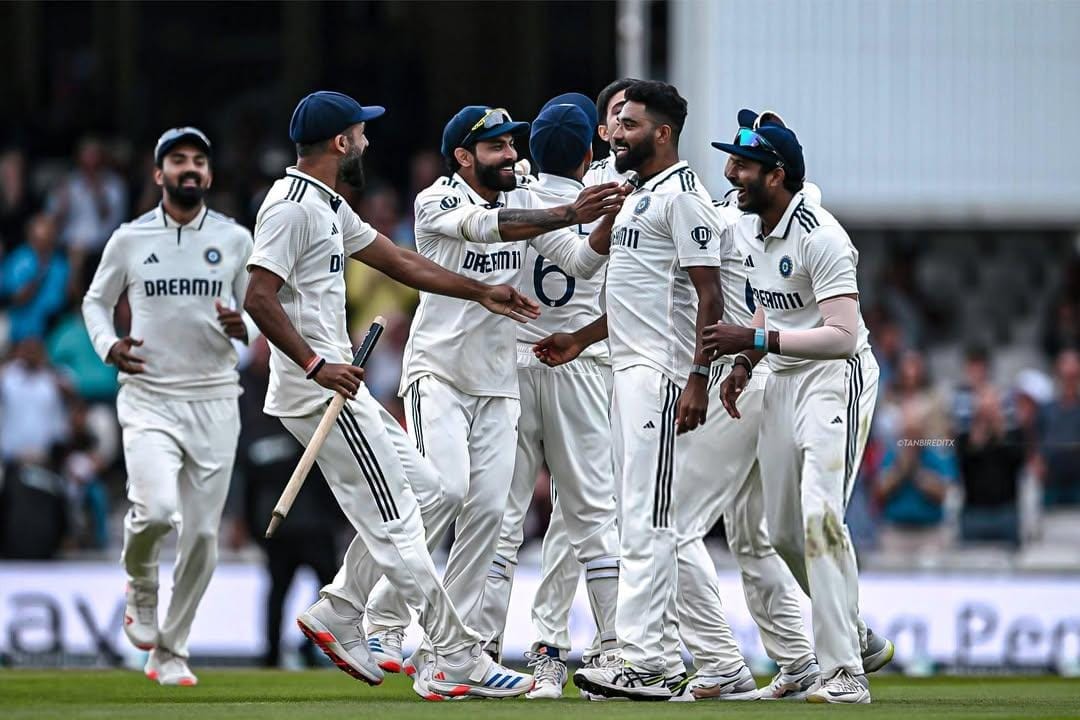Yashasvi Jaiswal’s standout performance set the tone as India edged past England by just 6 runs at The Oval, securing their narrowest Test win ever.
In the 56 minutes of breathtaking theatrics at the Oval, Siraj embodied belief, tearing through the England’s tail. The moment Siraj bowled a yorker to Atkinson, the emotions ran high, and the players ran into each other and hugged. The Indian flag was waved in the stands, and a stunned audience at the Oval was witnessing history in the making.
Emotions ran high in the stadium. Everyone has teary eyes, whether it was players or spectators. It wasn’t a win; it was the statement that India’s young brigade will keep the test cricket alive. This win is proof that no matter what happens in cricket, test cricket will always remain the pinnacle of the sport.
Siraj’s spell: A moment that froze time
Out of a series with many thrilling passages, I would argue that nothing could come close to the unseated rawness of that last 56 minutes at The Oval. As England needed just seven runs with one wicket remaining, the pressure was staggering. By contrast, Mohammed Siraj existed in the fire. Often described as energetic and aggressive, there was the ball of the series, a perfect yorker ripped out Gus Atkinson’s stumps, which sent Indian players into havoc mode.
This was a ball that every bowler dreams about, and every batter runs from in their nightmares. Siraj’s valiant efforts of 5 for 104 in the context of pushing back expectations earlier in the match don’t even begin to capture the reality of a cricketer. Someone who followed an instinctive belief, rhythm, and emotional fuel to bow under the most confined pressure. In that time, he was more than a fast bowler; he was India’s heart.
The visuals of Siraj celebrating and his teammates running towards him will live long in cricketing folklore. That single ball didn’t just win a Test match; it portrayed the raw, poetic beauty of Test cricket in a nutshell. Also, did poetic justice to Siraj. He was at the receiving end when an unlucky dismissal happened at Lord’s, and now he rattled the stumps to make sure India won.
India’s fighting spirit, from collapse to comeback
This was not a match that India was supposed to win. Not when England were 301 for 3, Joe Root and Harry Brook well-set and just 73 runs away from victory. But Test cricket, just like life, tests the brave and relishes brutal outcomes. India would not blink. The collapse that then ensued for England was not random; it was forced, modelled by India’s dogged spirit.
Every catch taken, every bowling change executed with zeal. Akash Deep contributed significantly, Prasidh Krishna maintained composure under immense pressure, and the fielders circled like eagles. This collective effort challenged what appeared to be an inevitable defeat. The context amplifies the achievement.
India had previously lost momentum in the series, faced a series of injuries, navigated leadership changes, and contended with unfavorable playing conditions. Despite these setbacks, the team demonstrated tenacity and strategic acumen. This was not a display of dominance, but rather a testament to perseverance and adaptability under pressure. The narrative had shifted, from a side facing imminent defeat to one that accomplished one of the most remarkable comebacks in recent memory.
Captain Gill’s calm in the storm
Shubman Gill, in his first full series as Test captain, managed to carry himself with a calm authority that exuded confidence throughout the group. It is not easy to lead a team in transition against a good England side in their backyard. But Gill’s calls from field placements to bowling changes were insightful, timely, and brave. He read the game well and remained level-headed throughout, even while it felt like England was strolling toward victory.
More than a tactician, Gill was a calming presence. His form with the bat,754 runs including four centuries, represented his captaincy while setting the example for India’s fighting spirit. What shone most was his body language, on point, unfazed, and quietly assertive.
When Siraj came steaming in for the final over, it was Gill at slip, eyes wide, encouraging his bowler with little flicker of doubt. That same calm presence reflected into the team. In the post-match interview, he didn’t talk about individual glory, but the team belief, and a process comment that spoke to both maturity and leadership vision. In every sense, a captain was born.
Test Cricket is meant to be forever
The fifth Test at The Oval wasn’t just any sporting contest – it was a love letter to Test cricket. In an age when T20 leagues acquire the media, hype, and attention that Test cricket could not hope to obtain, the fifth Test provided a timely reminder of the unique depth and drama Test cricket has to offer.
Over five days of ebb and flow, both teams exchanged the momentum in thrilling passages of play. It was not adrenaline induced by big hits or flashing lights that created tension, but rather the slow build of strategy, resilience, and pressure. When the last wicket fell just six runs short of England, it was a moment that reminded fans why they fell in love with the format.
No artificial hype – just cricket. The match had heart, heritage, and high stakes. For youngsters who were watching Test cricket for the first time, this was a perfect starting point. For the Test purists, it was vindication. The Oval became a stage, and in that final 56 minutes, the oldest format of the game reminded us how it can still deliver the timeless magic.


[…] India’s closest test victory by 6 runs at The Oval […]
[…] India’s closest test victory by 6 runs at The Oval […]